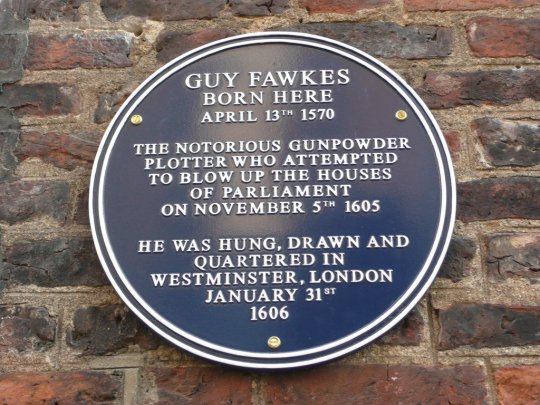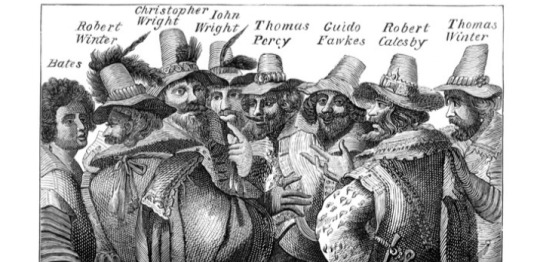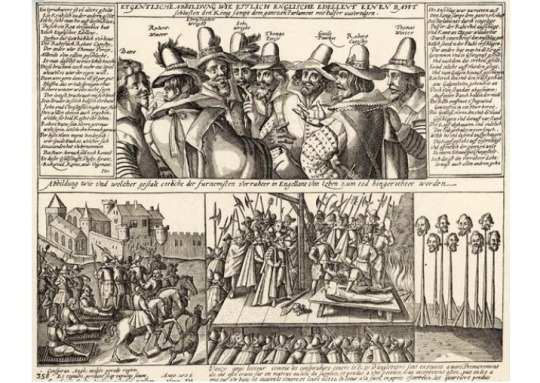#5 November 1605
Explore tagged Tumblr posts
Text

A historic plaque marks Guy Fawkes's birthplace in York. According to legend he leapt off the scaffold and broke his neck before being drawn and quartered, thus escaping the grisly fate of his co-conspirators.
#Guy Fawkes#Gunpowder Plot#Bonfire Night#York#England#5 November 1605#British history#treason#On this day#UK
67 notes
·
View notes
Text
Guy Fawkes and the Gunpowder Plot

By Ben Johnson
Published 30 October 2020
Remember, Remember, the 5th of November, Gunpowder, Treason and Plot!
Fireworks can be seen all over France every July 14 as the nation celebrates Bastille Day.
Across the USA some ten days earlier on the 4th of July, Americans celebrate their Independence Day.
In Britain, the words of a children’s nursery rhyme “Remember, Remember the 5th of November, Gunpowder, Treason and Plot” are chanted as fireworks fly and bonfires gradually consume a human effigy known as the ‘Guy.’
So who was this Guy? And why is he remembered so fondly 400 years after his death?
It could be said that the story started when the Catholic Pope of the day failed to recognise England’s King Henry VIII‘s novel ideas on separation and divorce.
Henry, annoyed at this, severed ties with Rome and appointed himself head of the Protestant Church of England.
Protestant rule in England was maintained and strengthened through the long and glorious reign of his daughter Queen Elizabeth I.
When Elizabeth died without children in 1603, her cousin James VI of Scotland became King James I of England.
James had not been long on the throne before he started to upset the Catholics within his kingdom.
They appear to have been unimpressed with his failure to implement religious tolerance measures, getting a little more annoyed when he ordered all Catholic priests to leave the country.
A group of Roman Catholic nobles and gentlemen led by Robert Catesby conspired to essentially end Protestant rule with perhaps the biggest ‘bang’ in history.
Their plan was to blow up the King, Queen, church leaders, assorted nobles, and both Houses of Parliament with 36 barrels of gunpowder strategically placed in the cellars beneath the Palace of Westminster.
The plot was apparently revealed when the Catholic Lord Monteagle was sent a message warning him to stay away from Parliament as he would be in danger, the letter being presented to Robert Cecil, James I’s Chief Minister.


Some historians believe that Cecil had known about the plot for some time and had allowed the plot to ‘thicken’ to both ensure that all the conspirators were caught and to promote Catholic hatred throughout the country.
And the Guy? Guy Fawkes was born in Yorkshire on 13 April 1570.
A convert to the Catholic faith, Fawkes had been a soldier who had spent several years fighting in Italy.
It was during this period that he adopted the name Guido (Italian for Guy), perhaps to impress the ladies.
What we do know is that Guido was arrested in the early hours of the morning of November 5th 1605, in a cellar under the House of Lords, next to the 36 kegs of gunpowder, with a box of matches in his pocket and a very guilty expression on his face.
Under torture, Guy Fawkes identified the names of his co-conspirators. Many of these were the relations of a Catholic gentleman, Thomas Percy.
Catesby and three others were killed by soldiers while attempting to escape.
The remaining eight were imprisoned in the Tower of London before being tried and executed for High Treason.

They experienced that quaint English method of execution, first experienced almost 300 years earlier by William ‘Braveheart’ Wallace.
They too were hanged, drawn, and quartered.
*Hanged, drawn and quartered:
Victims were dragged on a wooden hurdle behind a horse to the place of execution where they were first of all hanged, then their genitals were removed.
They were disembowelled and beheaded.
Their bodies were finally quartered, the severed pieces often displayed in public.

—
Guy Fawkes (13 April 1570 – 31 January 1606), also known as Guido Fawkes while fighting for the Spanish, was a member of a group of provincial English Catholics involved in the failed Gunpowder Plot of 1605.
The Gunpowder Plot of 1605, in earlier centuries often called the Gunpowder Treason Plot or the Jesuit Treason, was an unsuccessful attempted regicide against King James I by a group of English Catholics led by Robert Catesby, who considered their actions attempted tyrannicide and who sought regime change in England after decades of religious persecution.
The plan was to blow up the House of Lords during the State Opening of Parliament on 5 November 1605, as the prelude to a popular revolt in the Midlands during which King James's nine-year-old daughter, Princess Elizabeth, was to be installed as the new head of state.
#Guy Fawkes#Guido Fawkes#Gunpowder Plot of 1605#Gunpowder Treason Plot#Jesuit Treason#King James I#Robert Catesby#5 November 1605#House of Lords#State Opening of Parliament#King Henry VIII#Queen Elizabeth I#King James I of England#Palace of Westminster#Lord Monteagle#Robert Cecil#Thomas Percy#Tower of London#High Treason
50 notes
·
View notes
Photo

The 1605 Gunpowder Plot was a failed attempt by pro-Catholic conspirators to blow up the English Parliament on 5 November and kill King James I of England (r. 1603-1625) and the entire nobility along with him. The plot was discovered when one of the conspirators sent an anonymous letter warning a relative who would have been present in the parliament. At midnight on 4 November, Guy Fawkes was apprehended beneath Westminster Palace before he had a chance to light the 35 barrels of gunpowder stored in the palace’s cellars. Under brutal torture in the Tower of London, Fawkes revealed the names of his fellow conspirators and their plans to cause such chaos that a coup d’etat by forces favourable to the Catholic cause would be possible. Rounded up and also tortured, the guilty parties, including Guy Fawkes, were executed by the gruesome method of being hanged, drawn, and quartered, a fate reserved for those guilty of treason against the Crown. Bonfires were lit on the night of 5 November to celebrate the failure of the plot and this tradition continues today in an occasion on that date variously known as ‘Bonfire Night’, ‘Guy Fawkes’ Night’ or ‘Fireworks Night’.
92 notes
·
View notes
Text



An illustration depicting Guy Fawkes and the other men behind the failed Gunpowder Plot of 1605 "Every year on November 5, skies across England, Scotland and Wales are illuminated by fireworks as Brits head out into the night to enjoy Guy Fawkes Night celebrations.
Also called Fireworks Night or Bonfire Night, this autumn tradition has been a staple of the British calendar for the past 400 years. Fawkes was an explosives expert, and he was the one who got caught under the Houses of Parliament next to the stash of gunpowder, hence his notoriety."
33 notes
·
View notes
Text
I was rereading about the gunpowder plot for my English exam and made me think about how it might have inspired some events in Shades of magic.
The gunpowder plot was an attempted regicide against king James I and it happened on November 5th, 1605. The plot didn't happen because an anonymous letter tipped the royal family about it. This event is commemorated as the bonfire night.
Rhy's birthday is November 4th and from the starting of the series someone has tried to get rid of him and his family. In adsom, on the night of the annual celebrations for his birthday, so Nov. 4/5, Astrid and Athos tried to cause havoc in RL and a lot of people died, including Rhy. November 5 is the day of Rhy's death but also the night Kell bound his life to his and saved him. This event is remembered as the black night.
After Rhy became king, his opponents have tried to attempt on his life even more without success, because we know that Rhy will truly die if Kell dies. The Hand in TFTOP is a Guy Fawkes kind of plot as well and they will try to eradicate the Maresh family several times until they are caught. And I well, I guess we will see more "gunpowder" plots in future Threads books because they all think they have caught the culprit, but they are so wrong. So when the Guy Fawkes of TFTOP strikes again, they won't probably see them coming
#murder attempts to royals is nothing new but it amused me that Rhy was born the day before the gunpowder plot yk?#shades of magic#rhy maresh#a darker shade of magic#the fragile threads of power#tw death#I think that som events borrow a lot from british history but it makes sense since they are a london too
19 notes
·
View notes
Text

The staggeringly ambitious plan for 5 November 1605 was to blow up the Houses of Parliament during its next opening ceremony, killing not only the king but England's lords, bishops, and judges.
#history#historyfiles#guy fawkes#bonfire night#5th of november#fireworks night#guy fawkes night#fireworks#houses of parliament#gunpowder plot
3 notes
·
View notes
Text
Reminder:
Tomorrow is a very important day.
On November 5, 1605 English Catholic conspirators mounted a failed assassination plot against King James I and the destruction of Parliament. Now we burn little voodoo dolls of Guy Fawkes in remembrance just because. If you’ve seen V for Vendetta, this is all likely very confusing to you. Source below.
3 notes
·
View notes
Text
My entry: "The Fifth of November." - Aressida. 5.11.23.
I now know more about the failed Gunpowder Plot of 1605, which took place on November 5th, and involved a small group of Catholic conspirators who sought to alter the path of history.
It was one of history's most audacious plots.
It all began in 1604, when King James I declared openly that Catholicism was a superstition.
The conspirators of the Gunpowder Plot, under the leadership of Robert Catesby, were devout Roman Catholics furious with King James I for not allowing Catholics more religious tolerance.
The plotters planned to light a fuse on several gunpowder barrels, 36 of them, that were kept in a rented cellar beneath the Houses of Parliament. This was intended to take place on November 5, 1605, at the start of a new Parliament session including King James I.
The plan came dangerously close to succeeding, but it was only discovered by an anonymous letter to the authorities.
Unfortunately, Fawkes was captured, and the King granted a special order to have him taken to the Tower of London and subjected to torture. Medieval torture device known as "The Rack." Then, in the first month of the year 1606, Fawkes and the remainder of his co-conspirators were pronounced guilty of the capital offense of high treason and were handed down the severe punishment of death, specifically through the methods of hanging, drawing, and quartering.
During the severe political and religious upheaval of the 1500s and 1600s, interrogations frequently involved the use of torture to extract information.
Following the plot's discovery, revelers in London started setting off celebratory bonfires, and in January 1606, a parliamentary act declared November 5 to be a day of gratitude - Thanksgiving. And, Guy Fawkes Day. A reminder to traitors.
All the publicity over the past four centuries has gone to Fawkes, became its figurehead, even though Catesby was the mastermind.
In some circles today, Guy Fawkes is considered as a revolutionary hero because of the 1980s graphic novel "V for Vendetta" and the 2005 film of the same name, which featured a protagonist wearing a mask and fighting against a fascist government in a prospective version of Britain.
The theme of resistance to tyrants and dictators has become more relevant in today's world. The masks are a gesture of unity against political and corporate greed.
Remember, remember the 5th of November.

11 notes
·
View notes
Text
"What is Guy Fawkes Day"


A bit of context for the fandom: Guy Fawkes Night, also known as Guy Fawkes Day, Bonfire Night and Fireworks Night, is an annual commemoration observed on 5 November, primarily in Great Britain, involving bonfires and fireworks displays. Its history begins with the events of 5 November 1605 O.S., when Guy Fawkes, a member of the Gunpowder Plot, was arrested while guarding explosives the plotters had placed beneath the House of Lords. The Catholic plotters had intended to assassinate Protestant king James I and his parliament.
-Source, Wikipeadia
"Remember, remember, the 5th of November, Gunpowder, treason and plot. I see no reason Why gunpowder treason Should ever be forgot."


15 notes
·
View notes
Text
Boys, guys

According to commonly held thought, though the sourcing on all the sites I see use a lot of "it is believed" -- the word "guy" was derived from Guido Fawkes, or Guy Fawkes, of the Gunpowder Plot of 1605 fame. Key evolutionary point feom Wikipedia:
In Britain, 5 November has variously been called Guy Fawkes Night, Guy Fawkes Day, Plot Night, and Bonfire Night (which can be traced directly back to the original celebration of 5 November 1605). Bonfires were accompanied by fireworks from the 1650s onwards, and it became the custom after 1673 to burn an effigy (usually of the pope) when heir presumptive James, Duke of York, converted to Catholicism. Effigies of other notable figures have found their way onto the bonfires, such as (all the noted politicians). The "guy" is normally created by children from old clothes, newspapers, and a mask. During the 19th century, "guy" came to mean an oddly dressed person, while in many places it has lost any pejorative connotation and instead refers to any male person and the plural form can refer to people of any gender (as in "you guys").
Mildly curious on a plausible rise of use as a standard in informal vernacular over, here we see boys -- which I think is the case.
#Archie Comics#Archie Andrews#Veronica Lodge#Train station#Airport#goodbyes#Guy#Etymology#Guy Fawkes#1956#Dan Decarlo#1988#Private plane#Bill Vigoda(?)
3 notes
·
View notes
Text
5 Noyabrı xatırla, partlamanı, xəyanəti və sui-qəsdi.
Film 1605-ci ildə Guy Fawkes adlı şəxsin həbs edilməsi və öldürülməsi səhnəsi ilə başlayır. Guy Fawkes(1570 1606) katolik bir ailənin övladı kimi, katoliklərə qarşı təzyiqlərin çox olduğu bir dönəmdə yetişdirilmiş və bir müddət sonra ölkəni tərk edərək Protestant İngiltərəyə qarşı döyüşən katolik ordularında xidmət etmişdir. 1605-ci ildə İngiltərə Parlament binasını partlatmaq istəyirdi. Bu sui-qəsd avtoritar İngiltərə rejimini yıxmaq məqsədi daşıyırdı. Məhz bu səbəbdəndir ki, Guy Fawkes, xüsusilə avtoritar rejimə qarşı mübarizə aparan anarxist tərəflərin simvolu halına çevrilib. Lakin sui-qəsd hökumətə xəbər verildi və ifşa edildi. Guy Fawkes Noyabrın 5-də həbs edildi və o, 1606-cı ildə vətənə xəyanət ittihamı ilə edam edildi.
“Remember, remember, the fifth of November”, bu sözlər İngilis xalq mahnısına aiddir. Beləki, Guy Fawkes hazırda hər il 5 Noyabrda İngiltərədə Guy Fawkes Gecəsi(Bonfire Night) adı ilə keçirilən tədbirlərdə yad edilir. Bu tarix həm də İngiltərə tarixində Katolik Protestant münaqişələrinin ciddi bir mərhələsi kimi yadda qalıb.
Protestantlıq, Xristianlığın üç əsas qolundan biridir(digərləri Katoliklik və Provaslavlıqdır). 16-cı əsrdə Martin Luther və digər reformatorların Katolik Kilsəsinə qarşı başlatdığı Reformasiya Hərəkatı nəticəsində yaranmışdır. Luther məşhur 95 tezis(qanun) ilə tanınır. Bu tezislər Protestantlığın əsasını qoydu. Buu yenilik, Avropada Qaranlıq Dövrü(Dark Ages) bitirməklə yanaşı Renessans və Reformasiyanın təməlini atdı.
Necə oldu İngiltərə Protestant oldu?
İngiltərənin Protestantlığa keçidinin başlanğıcı Kral 8-ci Henri ilə əlaqəlidir. 8-ci Henri, Roma Papasından ilk həyat yoldaşı Ketrin ilə nikahını ləğv etməsini istədi, çünki Ketrin oğlan övlad dünyaya gətirməmişdi və Henrinin soyu davam etmə təhlükəsi ilə üz-üzə idi. Lakin Papa bu boşanma tələbini rədd etdi. Bu rəddən sonra Henri Roma Katolik Kilsəsinə qarşı çıxmışdı.
1534-cü ildə Üstünlük Aktı( Act of Supremacy) qəbul edildi və Henri özünü İngiltərə Kilsəsinin başçısı elan etdi.
Beləliklə, İngiltərə Roma Papasından müstəqil bir kilsə yaratdı. Bu isə öz növbəsində İngilis Reformlarının əsasını qoymuş sayılır. Katolik Kilsədən ayrılmaq Anglikan Kilsəsini ortaya çıxardı və bu reforma görə kilsə birbaşa krala tabe oldu.
Orta əsrlərdə kralların hakimiyyətinin Tanrı tərəfindən verildiyi inanışı geniş yayılmışdı. Bu konsepsiyaya görə, kral Tanrının yer üzündəki nümayəndəsi sayılırdı. Katolik Kilsəsi, bu anlayışı dəstəkləyərək kralların taxta çıxmasını leqallaşdıran əsas dini güc idi. Roma Papası və ya yüksək rütbəli kilsə rəsmiləri krallara tac qoyur, bu isə kralın Tanrının lütfü ilə hakimiyyətə gəldiyini simvolizə edirdi. Tacqoyma mərasimi olmadan bir çox hallarda kralın hakimiyyəti qeyri-legitim sayılırdı. Papalar çox vaxt siyasi münaqişələrdə də iştirak edir və kralları dəstəkləmək və ya onlara qarşı çıxmaq üçün öz nüfuzlarını istifadə edirdilər. Kilsə bəzi hallarda kralları taxtdan endirmək üçün digər siyasi gücləri təşviq edirdi. Papa bir kralın qanunsuz olduğunu elan edərək digər liderlərə, krala qarşı müharibə elan etmə haqqı verə bilərdi. İngiltərədə, kilsə reformları Katolik Kilsənin və Papaların bu gücünü əlindən almış oldu.
Daha sonra hakimiyyətə gələn krallar dönəmində də bir sıra islahatlar keçirildi və Katolik Kilsədən daha da uzaqlaşdılar. 6-cı Eduard(1547-1553) hakimiyyəti dönəmində Anglikan Kilsəsi tamamilə Protestant ideologiyalara uyğunlaşdırıldı. Kraliça 1-ci Elizabet(1558-1603) taxta çıxdıqdan sonra Protestantlıq rəsmi şəkildə ölkənin dininə çevrildi. Bu dəyişikliklər nəticəsində İngiltərə Protestant bir ölkəyə çevrildi.
Bütün bu dəyişiklikdən sonra Katoliklər və Protestantlar arasında uzun müddət dini qarşıdurmalar yaşandı. Guy Fawkesin uğursuzluqla nəticələnən sui-qəsd cəhdi də bu münaqişələrin ən ciddi nümunələrindən biridir.
"V for Vendetta" filmi Guy Fawkesi yenidən populyar mədəniyyətin mərkəzinə gətirib. Guy Fawkes kimi, filmin əsas qəhrəmanı "V" də avtoritarizmə qarşı çıxır və filmdə hadisələr bu yöndə cərəyan edir. Film eyni zamanda Guy Fawkes Maskası deyilən bir anlayışın da formalaşmasında böyük rol oynayır hansı ki, bu maska günümüzdə anarxist ideologiyada tez-tez istifadə edilir. Film 2005-ci(təqdimatı 2006-cı il) ildə eyni adlı qrafik romandan ilhamlanaraq çəkilib. Filmin çəkilməyə başlama və təqdimat illəri də xüsusi detallardan biridir. Ssenaristlər, film çəkildiyi vaxtlarda Wachowski qardaşları(sonralar wachowski bacılarına çevirdilər özlərini) adı ilə tanınırdılar, daha dəqiq desək Matrix filmləri ilə mükəmməl məşhurluğa sahib idilər. Bu filmdə də hadisələr Wachowskilərə uyğun şəkildə, gələcəkdə və distopik şəkildə cərəyan edir.
Yaxın gələcəkdə İngiltərə avtoritar rejim tərəfindən idarə edilir və Sutler(adı tanış gələ bilər) adlı diktatorun rəhbərlik etdiyi "Norsfire" hökuməti, xalqı qorxu və təzyiq altında saxlayır.
Bu hökumətin təhlükəsizliyindən məsul şəxs Peter Creedy, reala yaxın, gözəl düşünülmüş personajdır.
Maskalı karizmatik baş qəhraman V, bu rejimə qarşı təkbaşına mübarizə aparır. O, Guy Fawkes maskası taxaraq hökumətin törətdiyi bütün zülmlərə qarşı çıxır və 5 Noyabrda Parlament binasını partlatmaq istəyir.
Filmin çatdırmaq istədiyi əsas fikirlərdən biri, Azadlıq və dirəniş(etiraz).
Fərd şəklində vəya kütlələr şəklində insanlar öz azadlıqları üçün zülmə qarşı mübarizə aparmalıdırlar. İnsanlıq tarixi boyunca azadlıq və dirəniş hər bir cəmiyyətin mərkəzi mövzularından biri olmuşdur və bunlar fərdi və kollektiv kimliyin qorunması, ədalət uğrunda mübarizə və ən əsası avtoritarizmə qarşı çıxışın əsas sütunlarını təşkil edirlər.
Sadə dillə desək, azadlıq insanın öz həyatını idarə etmək hüququdur:
istədiyi kimi düşünmək(düşüncə azadlığı)
istədiyinə inanmaq(vicdan azadlığı)
istədiyini danışmaq(söz azadlığı)
istədiyi kimi hərəkət etmək(fərdi azadlıq).
Rousseauya görə insan, yalnız öz iradəsini və ağlını istifadə edərək həqiqi azadlığa nail ola bilər, yenə qeyd edirki, insanlar öz fərdi azadlıqlarının bir qismini ümumi rifah üçün qurban verir və bununla da cəmiyyətin tələblərinə uyğun şəkildə birgə yaşamaq mümkün olur, cəmiyyətin qanunları ümumi iradəyə əsaslandıqda, fərdlər həm qanunlara tabe olur, həm də azad qalır, çünki bu qanunlar onların ümumi maraqlarını ifadə edir. Bu mövzuda Russonun The Social Contract kitabını məsləhət görürəm. Mən Türkcə oxumuşdum, Hasan Ali Yücel Klasikleri seriyasında var Toplum Sözleşmesi adında.
Bütün bu azadlıqların məhdudlaşdırıldığı bir cəmiyyətdə hərzaman fərdi və kollektiv şəkildə etirazlar olmuşdur. Totalitar və Avtoritar rejimlərdə bütün bu azadlıqlar məhdudlaşdırılır və müxtəlif metodlarla etirazların qarşısı alınır. Hər iki rejimdə təbliğat və repressiyalardan istifadə edilərək öz hakimiyyətlərini möhkəmləndirirlər və bu rejimlərdə hakimiyyət bir grup şəxsin əlində cəmləşir. Bu iki rejimin oxşar cəhətlərlə yanaşı fərqli cəhətləri də var. Ən önəmli fərqli cəhətləri isə Totalitarizmdə məcburi ideologiyanın ön planda olmasıdır, misal üçün faşizm, kommunizm, şəriət kimi. Avtoritar rejimdə isə ön planda olan məsələ hakimiyyəti qorumaqdır, ideologiya ikinci plandadır. Avtoritarizmin tətbiqi və dərəcəsi ölkədən ölkəyə dəyişir. Avtoritar ölkəyə misal çəkməyəcəm, özünüz başa düşün. Filmdə təsvir edilən rejim Avtoritar rejimi bütün tərəfləri ilə izləyiciyə təqdim edir. Və zamanla Avtoritar rejim Totalitar rejimə çevrilir.
İzləyiciyə çatdırılmaq istənən fikirlərdən biri də bu rejimin ən önəmli idarə metodu, Qorxu və Təzyiq metodudur. Rejim, insanları qorxu vasitəsilə idarə edir, daim bir düşman var və ona qarşı hökumətin yanında olub, hökuməti dəstəkləmək lazımdır. Nəticədə azadlıqlarından məhrum edilmiş itaətkar fərdlər yaradılmış olur. Təzyiqlər nəticəsində insanlar öz ölkələrini tərk etməyə məcbur qalırlar və cəmiyyətdəki etirazın müqaviməti pozulmuş olur.
Buna bənzər bir rejimlə idarə edilən distopik bir cəmiyyətə 1984(George Orwell) romanında şahidlik edirik. Əsas qəhrəman Winston Smithin gözündən, qorxu və təzyiqin cəmiyyətdə necə tətbiq edildiyini görürük.
Gələk əsas məsələyə.
İdeyanın gücü:
Filmin sonlarına yaxın əsas personaj V, Sutlerin adamları tərəfindən əhatəyə alınır və güllələnir, amma, ayaqüstədir yıxılmır və belə bir ifadə işlədir:
Fikirlərə güllə işləməz.
Bu replika əslində filmin bütün mahiyyətini ortaya qoymuş olur. Bu ifadə eyni zamanda insanların düşüncələrini və ideyalarını məhv etmək üçün tətbiq edilən zorakılıq və şiddətin uğursuz olacağını vurğulayan dərin mənalı ifadədir. Film boyunca V tərəfindən xalqın azadlığını, müstəqilliyini və düşüncə azadlığını qorumağa yönəlmiş bir ideya ön planda dayanır. O, totalitar rejimin qarşısında dayanıb xalqın yuxusundan oyanmasını istəyən bir şəxs olaraq, insanların öz azad fikirlərini qorumasını istəyir və buna görə mübarizə aparmağı təklif edir. Bu deyim, həm də filmin sonlarına doğru, V-nin öz həyatını və mübarizəsini sona çatdırarkən, azadlıq, bərabərlik və ideya mübarizəsinin hər zaman davam edəcəyini vurğulayan, simvolik bir cümlə halını alır. V for Vendetta, totalitarizm(avtoritarizm) və azadlıq; mübarizə və qorxu; ideallar və güc arasında gedən fəlsəfi bir mübahisədir. Film, həm də azad fikirlərin gücünü və rejim qarşısında insanların müqavimətini göstərən dərin bir fəlsəfi mesaj verir. Ortaya bəzi suallar çıxır:
İnsan azadlığının qiyməti nədir?
Düşüncə və şəxsiyyətin əsl gücü nədir?
Rejimin qarşısında necə dayana bilərik?
Son olaraq, Vnin mübarizəsinin, yalnız dövlətin dağıdılması üçün deyil, eyni zamanda insanların içindəki azadlıq və şəxsi gücü ortaya çıxarmaq üçün olduğunu öyrənirik. Filmin sonunda, Evey(V-nin sonradan tanış olduğu və öz dəyişimi ilə xəyal edilən cəmiyyəti təmsil edən ikinci əsas personaj) öz şəxsiyyətini, fikirlərini və azadlığını tapır, bu isə hər bir insanın daxili gücünü kəşf etməsi və azadlıq uğrunda mübarizə etməsi mesajını verir.
Bu filmdə işin texniki tərəflərindən danışmağın mənası yoxdur, danışılması lazım olan nüanslar başqadır, alınması lazım olan dərslər başqadır. Buna görə işin texniki tərəflərindən bu filmdə danışmaq mənasızdır.
Bunun əvəzinə filmdən bir neçə replika oxuyaq:
📍İnsanlar hökumətlərindən qorxmalı deyil, hökumətlər öz xalqından qorxmalıdır.
📍Bu maskanın altında yalnız ət yoxdur. Bu maskanın altında bir ideya var, cənab Creedy və ideyalara(fikirlərə) güllə işləməz.
📍İdeyalar təkcə qanla deyil, həm də təfəkkürlə yaşayır.
📍Sistemi dəyişmək asan deyil, amma, heç nə heç vaxt dəyişilməz deyil.
📍Qorxu insana nəzarət etmək üçün ən güclü vasitədir, lakin özünə inam insanı qorxudan daha güclü edir.
📍İnsanların qorxduğu şeylərdən çox, onları gizlədilən şeylər qorxudur.
📍Bəzən ən gözəl şeylər ən böyük mübarizələrdən sonra gəlir.
📍Yekun olaraq, maskanın altında kim olduğunu tapmaqdan çox, kim olacağımızı tapmaq daha vacibdir.
Mövzu ilə əlaqədar mənim də oxuduğum kitabların ətraflı siyahısı:
1984(George orwell)
The Social Contract(Jean Jacques Rousseau)
On Liberty(John Stuart Mill)
Brave New World(Aldous Huxley)
The Trial(Franz Kafka)
The Communist Manifesto( Karl Marx və Friedrich Engels)
Escape From Freedom(Erich Fromm)
V for Vendetta IMDb: 8,1/10
Xoş izləmələr.


0 notes
Text
The History and Significance of Guy Fawkes Night
Hist holds an essential role in understanding the cultural and historical events that have shaped the world. By delving into the past, we gain insights into significant traditions, including notable commemorations such as Guy Fawkes celebrations. Each day brings an opportunity to reflect on history, and November 5th stands out as a unique date marked by fireworks, bonfires, and community gatherings in the UK and beyond.
The origins of Guy Fawkes Night trace back to the early 17th century. On November 5, 1605, a dramatic event unfolded that could have altered the course of British history. A group of Catholic conspirators, including Guy Fawkes, plotted to blow up the Houses of Parliament to challenge Protestant rule and King James I. This plan, famously known as the Gunpowder Plot, was foiled before it could be executed. The arrest of Guy Fawkes and his subsequent interrogation marked the event as a pivotal moment in British history. Today, hist provides a comprehensive platform for exploring such intriguing chapters from the past.
As the years passed, November 5th transformed into an annual day of remembrance. Initially, it was celebrated as a Protestant triumph over treason, with sermons and official declarations. Over time, the solemnity of the day evolved into a more festive affair. Today, Guy Fawkes celebrations have become a vibrant expression of British culture, featuring fireworks, community bonfires, and effigies of Guy Fawkes being burned.
Beyond its historical context, the event carries cultural and symbolic significance. The fireworks represent the explosives intended for the Gunpowder Plot, while the bonfires highlight the unity of communities in celebrating resilience. These traditions have expanded over the centuries, and today, Guy Fawkes Night serves as an enduring symbol of rebellion, remembrance, and festivity.
Every day offers a chance to rediscover how events of the past influence modern traditions. The way communities worldwide have adapted and embraced Guy Fawkes Night reflects the global resonance of such events. From traditional British celebrations to modern reinterpretations in other nations, the night demonstrates how history can unite people in shared experiences and joyous commemoration. At DayHist, you can uncover more about similar events and their global impact.
0 notes
Text
The History and Significance of Guy Fawkes Night
Hist holds an essential role in understanding the cultural and historical events that have shaped the world. By delving into the past, we gain insights into significant traditions, including notable commemorations such as Guy Fawkes celebrations. Each day brings an opportunity to reflect on history, and November 5th stands out as a unique date marked by fireworks, bonfires, and community gatherings in the UK and beyond.
The origins of Guy Fawkes Night trace back to the early 17th century. On November 5, 1605, a dramatic event unfolded that could have altered the course of British history. A group of Catholic conspirators, including Guy Fawkes, plotted to blow up the Houses of Parliament to challenge Protestant rule and King James I. This plan, famously known as the Gunpowder Plot, was foiled before it could be executed. The arrest of Guy Fawkes and his subsequent interrogation marked the event as a pivotal moment in British history. Today, hist provides a comprehensive platform for exploring such intriguing chapters from the past.
As the years passed, November 5th transformed into an annual day of remembrance. Initially, it was celebrated as a Protestant triumph over treason, with sermons and official declarations. Over time, the solemnity of the day evolved into a more festive affair. Today, Guy Fawkes celebrations have become a vibrant expression of British culture, featuring fireworks, community bonfires, and effigies of Guy Fawkes being burned.
Beyond its historical context, the event carries cultural and symbolic significance. The fireworks represent the explosives intended for the Gunpowder Plot, while the bonfires highlight the unity of communities in celebrating resilience. These traditions have expanded over the centuries, and today, Guy Fawkes Night serves as an enduring symbol of rebellion, remembrance, and festivity.
Every day offers a chance to rediscover how events of the past influence modern traditions. The way communities worldwide have adapted and embraced Guy Fawkes Night reflects the global resonance of such events. From traditional British celebrations to modern reinterpretations in other nations, the night demonstrates how history can unite people in shared experiences and joyous commemoration. At DayHist, you can uncover more about similar events and their global impact.
0 notes
Text




Arrivals & Departures . 13 April 1570 – 31 January 1606 . Guy Fawkes . Gunpowder Plot . 05 November 1605
Guy Fawkes (/fɔːks/; 13 April 1570 – 31 January 1606),[a] also known as Guido Fawkes while fighting for the Spanish, was a member of a group of provincial English Catholics involved in the failed Gunpowder Plot of 1605. He was born and educated in York; his father died when Fawkes was eight years old, after which his mother married a recusant Catholic.
Fawkes converted to Catholicism and left for mainland Europe, where he fought for Catholic Spain in the Eighty Years' War against Protestant Dutch reformers in the Low Countries. He travelled to Spain to seek support for a Catholic rebellion in England without success. He later met Thomas Wintour, with whom he returned to England. Wintour introduced him to Robert Catesby, who planned to assassinate King James I and restore a Catholic monarch to the throne. The plotters leased an undercroft beneath the House of Lords; Fawkes was placed in charge of the gunpowder that they stockpiled there. The authorities were prompted by an anonymous letter to search Westminster Palace during the early hours of 5 November, and they found Fawkes guarding the explosives. He was questioned and tortured over the next few days and confessed to wanting to blow up the House of Lords.
Fawkes was sentenced to be hanged, drawn and quartered. However, at his execution on 31 January, he died when his neck was broken as he was hanged, with some sources claiming that he deliberately jumped to make this happen; he thus avoided the agony of his sentence. He became synonymous with the Gunpowder Plot, the failure of which has been commemorated in the UK as Guy Fawkes Night since 5 November 1605, when his effigy is traditionally burned on a bonfire, commonly accompanied by fireworks.
0 notes
Text

TODAY IN HISTORY: November 5, 1605 - Guy Fawkes was arrested in the cellars of the Houses of Parliament, where he had planted gunpowder in an attempt to blow up the building and kill King James I of England. The plan was to blow up the House of Lords during the State Opening of Parliament. An anonymous letter of warning was sent to William Parker, 4th Baron Monteagle, a Catholic member of Parliament, who immediately showed it to the authorities. Fawkes was discovered guarding 36 barrels of gunpowder—enough to reduce the House of Lords to rubble—and arrested. Hearing that the plot had been discovered, most of the conspirators fled from London while trying to enlist support along the way.
0 notes
Text
05.11.2024 – „Guy Fawks Day“
Der 5. November - ein Tag, der die britische Geschichte für immer veränderte. In der kühlen #Herbstluft Englands flackern Lagerfeuer und bunte #Feuerwerkskörper erhellen den Nachthimmel. Es ist Guy Fawkes Night, auch bekannt als Bonfire Night, ein Fest, das tief in der britischen Kultur verwurzelt ist.
Die Verschwörung, die #England erschütterte: Im Jahr 1605 plante eine Gruppe katholischer Verschwörer unter der Führung von #GuyFawkes einen kühnen Anschlag. Ihr Ziel: Das protestantische #Parlament und König James I. in die Luft zu sprengen. 36 Fässer #Schießpulver wurden heimlich in den Keller des Parlamentsgebäudes geschmuggelt.
Doch das #Schicksal hatte andere Pläne. Am Morgen des 5. November wurde Guy Fawkes auf frischer Tat ertappt, als er die explosive Fracht bewachte.
Von Verrat zu Tradition: Die Nachricht von der vereitelten #Verschwörung verbreitete sich wie ein Lauffeuer durch London. König James I., erleichtert über seine Rettung, erlaubte dem Volk, #Freudenfeuer zu entzünden. Was als spontaner Ausdruck der Erleichterung begann, entwickelte sich im Laufe der Jahrhunderte zu einer fest verankerten Tradition.
Ein Fest der #Lichter und des Gedenkens: Heute ist der Guy Fawkes Day ein farbenfrohes Spektakel. In den Straßen Englands ziehen Fackelumzüge durch die Nacht, begleitet vom Knistern der Lagerfeuer und dem Zischen der Raketen.
Kinder basteln "Guys" - Strohpuppen, die Guy Fawkes darstellen und traditionell auf den Scheiterhaufen geworfen werden.
Wandel der Bedeutung: Interessanterweise hat sich die Wahrnehmung von Guy Fawkes im Laufe der Zeit gewandelt. Von einem verurteilten #Hochverräter wurde er für manche zu einem Symbol des Widerstands gegen Tyrannei.
Seine ikonische Maske, bekannt aus "V for Vendetta", ist heute ein weltweit erkanntes Symbol für Anonymität und Aufstand.
Er ist ein Tag, an dem die #Vergangenheit in den flackernden #Flammen der Gegenwart tanzt und uns mahnt, nie zu vergessen: "Remember, remember, the fifth of November."
Text - Copyright © 2024 – Sonntag, 27. Oktober 2024 - Wᴇᴇᴘɪɴɢ_Aɴɢᴇʟ_¹³
instagram
0 notes